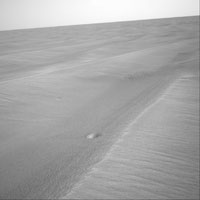

Image Below form NASA: Tiny Craters on Meridiani Planum These two craters, each smaller than a foot in diameter and less than one-half inch deep, were found intact by NASA's Mars rover Opportunity. Image credit: NASA/JPL

Christa McAuliffe
was a American teacher and astronaut from New Hampshire who died in the explosion of the Space Shuttle Challenger on STS-51-L. She was born Sharon Christa Corrigan in Boston, Massachusetts. McAuliffe was selected to be the first teacher in space on July 19, 1985. She joined the STS-51-L crew as a mission specialist with plans to teach lessons from space. Selected from among more than 11,000 applicants from the education profession for entrance into the astronaut ranks, McAuliffe had been born the oldest child of Edward and Grace Corrigan. Her father was at that time completing his sophomore year at Boston College, but not long thereafter he took a job as an assistant comptroller in a Boston department store and the family moved to the Boston suburb of Framingham. As a
Space Shuttle Columbia
Space Shuttle Columbia Shuttle Orbiter Columbia (NASA Designation: OV-102) was the first space shuttle in NASA's orbital fleet, first flying mission STS-1 from April 12 to April 14, 1981. It was lost with all crew when it disintegrated during re-entry on its 28th mission, STS-107, which lasted from January 16 to February 1, 2003. Table of contents showTocToggle("show","hide") 1 History 2 Final Mission 3 Cultural Reaction 4 Missions 5 Related articles 6
Instead they looked to reduce the year-to-year costs of development to a stable figure. That is, they wished to see the development budgets spread out over several more years. This is somewhat difficult to do--you can't build half a rocket. The result was another intense series of redesigns in which the re-usable booster was eventually abandoned as impossible to pay for. Instead a series of simpler rockets would launch the system, and then drop away for recovery. Another change was that the fuel for the shuttle itself was placed in an external tank instead of internal tanks from the previous designs. This allowed a larger payload bay in an otherwise much smaller craft, although it also meant throwing away the tankage after each launch.
Space Shuttle program
Space Shuttle program Space Shuttle Columbia, 1981 (NASA) NASA's Space Shuttle program is an ongoing endeavor, started in the late 1960s, that has created the world's first partially reusable space launch system, and the first spacecraft capable of carrying large satellites both to and from low Earth orbit. Each shuttle is designed for a projected lifespan of 100 launches. The original purpose of the program was to ferry supplies to a space station. In reality, the Shuttle is the United States' sole manned launch vehicle and has totally dominated NASA's operations since the mid 1970s. With the construction of the International Space Station the Shuttle has finally begun to be used for its original purpose. In January 2004, it was announced that the Shuttle fleet would
Astronaut
astronaut, cosmonaut or taikonaut is a person who travels into space, or who makes a career of doing so. The criteria for determining who has achieved human spaceflight vary. In the United States, persons who travel above an altitude of 50 miles (80 kilometers) are designated as astronauts. The FAI defines spaceflight as over 100 km. To March 3, 2003, a total of 437 humans by the US definition had spent a total of 26,320 crew-days in space including 98 crew-days of spacewalks. 431 people qualify under the FAI definition. Astronauts from at least 32 countries have gone into space. By convention, an astronaut employed by the Russian Aviation and Space Agency or its Soviet predecessor is called a cosmonaut. "Cosmonaut" is an anglification of the Russian word kosmonavt, which in
The final defining moment was when NASA, in desperation to see their only remaining project saved, went to the Air Force for its blessing. NASA asked that the AF place all of their future launches on the shuttle instead of their current expendable launchers (like the Titan II), in return for which they would no longer have to continue spending money upgrading those designs -- the shuttle would provide more than enough capability.
However reality was to interject and NASA found themselves with a rapidly plunging budget. Rather than stepping back and looking at their future as a whole given their new financial situation, they attempted to save as many of the individual projects as possible. The mission to Mars was quickly eliminated, but the Space Station and Shuttle continued on. Eventually only one of them could be saved, so it stood to reason that a low-cost Shuttle system would be the better bet, because without it a large station would never be affordable.
1998 in science
1999 in science and the list of years in science Table of contents showTocToggle("show","hide") 1 Astronomy and space exploration 2 Biology 3 Computer science 4 Geology 5 Mathematics 6 Medicine 7 Technology 8 Awards 9 Births 10 Deaths Astronomy and space exploration January 6 - The Lunar Prospector spacecraft is launched into orbit around the Moon and later found evidence for frozen water on the moon's surface. January 8 - Cosmologists announce that the expansion rate of the universe is increasing. March 2 - Data sent from the Galileo spaceprobe indicates that Jupiter's moon Europa has a liquid ocean under a thick crust of ice. March 5 - NASA announced that that the Clementine probe orbiting the Moon had found enough water in polar craters to support a human colony and